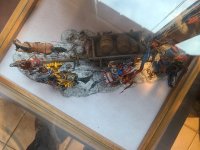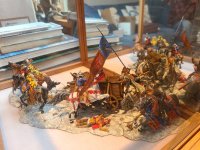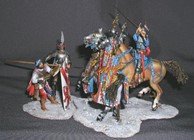You are using an out of date browser. It may not display this or other websites correctly.
You should upgrade or use an alternative browser.
You should upgrade or use an alternative browser.
New Acquisition - Battle of Herrings Diorama - Aeorart/Granada (1 Viewer)
- Thread starter tdubel
- Start date
Louis Badolato
Lieutenant General
- Joined
- Apr 25, 2005
- Messages
- 17,207
Awesome find Tom, but I’ve never heard of the Battle of Herring.

tdubel
Major
- Joined
- Jan 18, 2007
- Messages
- 6,527
Awesome find Tom, but I’ve never heard of the Battle of Herring.
I looked it up: The Battle of the Herrings, also called the Battle of Rouvray, was a military action near the town of Rouvray in France, just north of Orléans, which took place on 12 February 1429 during the siege of Orléans in the Hundred Years' War. The immediate cause of the battle was an attempt by French and Scottish forces, led by Charles of Bourbon and Sir John Stewart of Darnley, to intercept a supply convoy headed for the English army at Orléans. The English had been laying siege to the city since the previous October. This supply convoy was escorted by an English force under Sir John Fastolf and had been outfitted in Paris, whence it had departed some time earlier. The battle was decisively won by the English.According to Régine Pernoud, the supply train consisted of "some 300 carts and wagons, carrying crossbow shafts, cannons and cannonballs but also barrels of herring". The latter were being sent since the meatless Lenten days were approaching. It was the presence of this stock of fish which would give the somewhat unusual name to the battle.
As you know, I collect a lot of items that are unique and look cool!!!!!!!!! So there you have it.
TD
GICOP
Four Star General
- Joined
- Oct 16, 2008
- Messages
- 27,942
I looked it up: The Battle of the Herrings, also called the Battle of Rouvray, was a military action near the town of Rouvray in France, just north of Orléans, which took place on 12 February 1429 during the siege of Orléans in the Hundred Years' War. The immediate cause of the battle was an attempt by French and Scottish forces, led by Charles of Bourbon and Sir John Stewart of Darnley, to intercept a supply convoy headed for the English army at Orléans. The English had been laying siege to the city since the previous October. This supply convoy was escorted by an English force under Sir John Fastolf and had been outfitted in Paris, whence it had departed some time earlier. The battle was decisively won by the English.According to Régine Pernoud, the supply train consisted of "some 300 carts and wagons, carrying crossbow shafts, cannons and cannonballs but also barrels of herring". The latter were being sent since the meatless Lenten days were approaching. It was the presence of this stock of fish which would give the somewhat unusual name to the battle.
As you know, I collect a lot of items that are unique and look cool!!!!!!!!! So there you have it.
TD
Beautiful set Tom :salute::
Interesting to note we are still arguing with the French over fish..........you only need to read about the current Brexit talks:rolleyes2:
Stay safe mate
Martyn
wayne556517
Lieutenant General
- Joined
- Aug 28, 2007
- Messages
- 16,033
Magnificent set great find.
Here is the latest find, love it and it is a beauty, now I have to learn about the Battle of Herrings!!!!
View attachment 270010View attachment 270011View attachment 270012View attachment 270013
Hi, Tom!
Beautiful set, I saw this some years ago, and tried to buy it, but seller didn’t want to ship outside U.S.
I think it’s absolutely one of the best sets I have seen, and I also think Grenada/Grudsky delivers beautiful figure sets.
Best wishes Mattis
Sgtminiman
Specialist
- Joined
- Aug 2, 2013
- Messages
- 309
Absolutely stunning figures!
jason foote
2nd Lieutenant
- Joined
- Dec 7, 2014
- Messages
- 3,044
That is an amazing diorama Tom. Absolutely stunning
Jason
Jason
Users who are viewing this thread
Total: 2 (members: 0, guests: 2)






